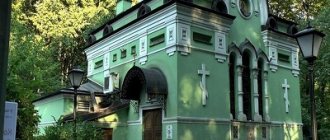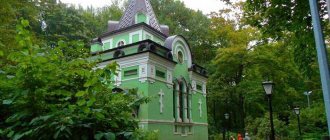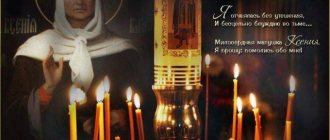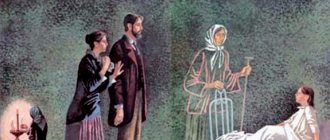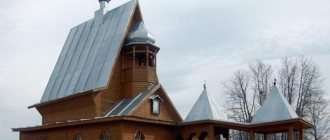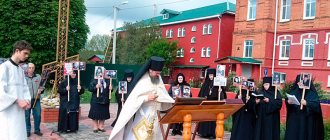Walking around the chapel of Xenia of St. Petersburg
People planning to visit the chapel of St. Xenia of St. Petersburg should know some of the actions that visitors perform:
- write a note-appeal. State in it a request to the saint;
- visit the chapel of Xenia of Petersburg, built at the Smolensk cemetery in St. Petersburg;
- approaching the chapel, you need to walk around it counterclockwise 3 times;
- You can leave your note in 3 places: in a special box for notes, under a box with candles or near the wall;
- being near a wall, you need to lean your forehead against it and mentally turn to the saint with your problem;
- put the candle in a special box on the street.
After completing the actions, you can go to the chapel and pray there, order a prayer service, and light candles to the icons. You cannot leave the chapel right away. You need to stand and have an internal conversation with Ksenia of Petersburg. Some sign may appear that the request has been heard. It could be some kind of knocking, ringing, or another sensation. You can wait until the priest asks to vacate the chapel for the next people. If there are few parishioners that day, then you can stay there until closing.
Preparing for the trip to the Chapel of Xenia of St. Petersburg
Of all the saints who are able to help in all everyday and life problems, Ksenia of St. Petersburg is singled out. During her lifetime, she gained the reputation of an extraordinary person who could make life easier with one touch, and foresaw events many days in advance. After her death, she was buried in the Smolensk cemetery, where a chapel was built in her honor. Since then, people have been going to the holy place, each with their own problem. Therefore, a whole ritual appeared that should bring the desired event closer.
When going on a trip to the chapel of Xenia of St. Petersburg, you need to take bread and some sweets with you. The bread can be given to birds, which are considered God's creatures, or given to animals. Sweets are left near the walls of the chapel. Before the trip, it is advisable to prepare mentally and physically. There is no need to drink alcohol or sin. But any good deeds are welcome: helping your neighbor or giving alms to those in need.
Many who have visited the chapel of Xenia of St. Petersburg confirm its healing effect. But they emphasize that the main thing is to believe in help, and then it will come. Therefore, it does not matter whether a person walks around the building or not. It’s better to find a prayer to Xenia of St. Petersburg and her akathist; you should read it on the way to the chapel, in line and in the chapel itself.
If a person cannot, due to various circumstances, get to the chapel, then in every church there is an icon of Xenia of St. Petersburg, near which you can pray and state your request.
The only one in the empire
A. Prostev. Matthias Garden
We are included in things above through personal circumstances, and therefore I will begin the story with my reasons. Until recently, I, alas, did not know about the only temple in the Russian Empire named in honor of the Apostle Matthias, my heavenly patron. But the presence of Blessed Xenia of St. Petersburg in my life had a very clear effect. Now two high names have closed in my mind...
The initial impetus for writing this article was the following fact: on the day of remembrance of the blessed one. Ksenia sent me on social networks a black and white picture of our contemporary, the artist Alexander Prostev, in an incomprehensible way connecting the city of Petrov from the era of blessed Ksenia Petrova, and the godless years that destroyed the Cathedral of St. Matthew, and even besieged Leningrad, and the eternal rainy weather of St. Petersburg... And all this, as if by a spiritual bond, it is closed by the figurine of an angel, eternally standing on the site of the consecrated altar - a temple that no longer exists on earth, but is forever registered in Heaven.
This picture, “where the temple of the Apostle Matthias stood,” according to the artist’s personal admission, is especially dear to him. He notes in a private letter: “Such a snow-white island in the middle of the city: everything around is melting, trampled, but this island is untouched, snow-white. That's how this story was born. We can say that the work is from life.”
A. Prostev. Blessed Xenia and the Church of the Apostle Matthias
How can we depict the repeatedly modified Matthias Church today? A. Prostev answers our direct question like this: “I depict exactly the church that was during the life of St. Ksenia. It is she who is depicted on the so-called. "Makhaevsky plan" of 1753. Subsequently, a new Church of the Intercession appeared next to it. Then both churches were demolished and a new stone church was built, which was later blown up under Soviet rule.”
They claim that the blessed saint’s favorite saints were her heavenly patroness, St. Ksenia of Milasskaya and the Apostle Matthias, in whose church, according to biography writers, blessed Ksenia of Petersburg confessed, took communion, got married and was buried. This apostle, a native of Bethlehem, was called out of the 70 by lot in the 12th - instead of the fallen Judas. Around 63 AD The holy Apostle Matthias was condemned to death by the Sanhedrin for preaching about Christ and stoned. When the saint was already dead, the Jews, hiding the crime, cut off his head as an opponent of Caesar. (According to other sources, Apostle Matthias was crucified on the cross. Some authors indicate that the saint died in Colchis).
The temple in which Blessed Ksenia was a parishioner (the modern address of the place where the Church of the Apostle Matthias stood is Petrogradskaya Side, Bolshaya Pushkarskaya St., 35, Matthias Garden) and where the Petrov spouses, Alexander Fedorovich and Ksenia Grigorievna, prayed dilapidated and wooden. In winter there was no heating in it, and it was sometimes simply painful to endure long service. However, the Petrovs went to church often.
Historian Vladimir Sinkevich, author of the book “The latest research on the life of St. bliss Xenia of Petersburg, parishioner of the Church of St. ap. Matthia" (2009), believes that the blessed Xenia the Blessed was born in 1732, the year of the earthly burial of Peter I, who died in 1725.
And the wooden church “about three spitz”, in the name of the holy apostles Peter and Paul, erected in the Peter and Paul Fortress on Hare Island in 1703, according to some information, according to the drawings of Peter I, was moved to the Petersburg side in 1719, where it was quartered Belozersky Infantry Regiment, and on January 31, 1720, it was reconsecrated in the name of the holy Apostle Matthias - in honor of the capture of Narva by Russian troops on August 9/22, 1704 (on the day of memory of the Apostle); On this day, Peter the Great prayed in this temple for the victorious end of the war with Sweden.
A. Prostev. Petersburg side. View of the Church of the Apostle Matthias. XVII century
Victoria was granted to Emperor Peter four years after the defeat at Narva. On the day of the celebration of the Transfiguration of the Lord, according to the records of Peter himself, at the time of the Liturgy, Divine help was sent to the Russian army: the Victoria bastion of the Narva fortress collapsed by itself, “then God gave this good chance that on the 6th day of August this bastion Honor so, for the reason of the bad foundation, from the outset the ditch cracked and collapsed so much that without the use of miners, the breach was found in such good condition.” The final victory took place three days later, on the day of memory of St. Matthias.
Around the church, moved to the Petrograd side, where the regiments were quartered and “where there is free and dry space,” a military cemetery was formed, where maimed soldiers and those who died from wounds were buried. There is information that in 1738 - 1768. the cemetery was quite extensive.
The soldiers of those battles sleep now on the site of the Matfievsky (in common parlance - Matveevsky, officially - Kalininsky) kindergarten, located opposite the current houses 27 and 29, on the corner of Kronverkskaya and Bolshaya Pushkarskaya streets and bounded on the other two sides by Lenin Street and Matveevsky Lane. Approximately in the center of the garden there is a low hill - here there was a temple in honor of St. Matthias.
We see these places in the paintings of Alexander Prostev in the 2000s cycle “The Life of St. Blessed Xenia of Petersburg.” Two works are called: “Early morning on Bolshaya Matfievskaya” (the street that led to the Church of the Apostle Matthias) and “Blessed Xenia and the Church of the Apostle Matthias.”
A. Prostev. Early morning on Bolshaya Matfievskaya
In this context, one should also take a closer look at the paintings of this hagiographic cycle “St. Andrew's Court by Night. Ksenia giving alms to a beggar boy”, “Alone in the whole world”, “Dawn. Premonition of a different existence” and others.
Architect D. Trezzini laid a stone foundation for the temple in the early 1730s. Under Anna Ioannovna, the church became a regimental one - for the Koporsky and St. Petersburg regiments stationed nearby. Through the efforts of the clergy and parishioners, in 1751 a bell weighing 114 pounds was cast for the church, which was considered one of the largest in the capital.
A. Prostev. Alone in the whole world
Since the Matthias Church was cold, even under Elizabeth Petrovna, a warm wooden one was built nearby - in the name of the Intercession of the Most Holy Theotokos, restored after a fire and consecrated in 1754. The inscription on the cross under the altar read: “Consecrate the altar of the Lord God and our Savior Jesus Christ, in the name The Most Holy Theotokos honors Her protection, under the most pious and autocratic power, the great Empress Elisabeth Petrovna and under her heir, grandson Peter, and Grand Duke Peter Feodorovich, under his wife, the blessed Empress Ekaterina Aleksievna, and under the blessed sovereign and Grand Duke Pavel Petrovich. With the blessing of the Holy Governing All-Russian Synod and the Most Reverend Sylvester, Archbishop of St. Petersburg and Shlisselburg and Archimandrite of the Holy Trinity and Alexander Nevsky. In the year of the Nativity of Christ 1754 indicts.”
After standing for about half a century, the Church of the Intercession became dilapidated and was dismantled, and in its place, in the late 1790s, construction began on a two-aisle, five-domed stone church with a wooden bell tower and a wooden dome - under the leadership of architect L.I. Miller, a student of the famous V.I. Bazhenova.
On October 1, 1800, the patronal feast day, the consecration of the new Church of the Intercession of the Blessed Virgin Mary with a two-tier iconostasis and a chapel of St. Sergius of Radonezh took place.
In June 1806, by the highest order of Emperor Alexander I (at the suggestion of L. Ruska), the Matthias Church was dismantled due to its extreme dilapidation, and instead of it, in the expanded Church of the Intercession, a chapel of the same name was consecrated, where the holy altar and iconostasis were moved from the old church (in reduced sizes). At the same time, in memory of the original church, the new Intercession Church was renamed Matfievskaya.
Church of the Apostle Matthias. Architect's drawing. V. I. Karpova. 1889
During the 19th century. The church was rebuilt and expanded more than once. At the same time, the iconostasis of the first wooden Peter and Paul Church was invariably kept in it.
Fortunately, historians and local historians have something to share with us. They say that the first major renovation in the temple in honor of St. Matthias was held in 1842. A new iconostasis by the Okhta master K.V. was installed in the Pokrovsky chapel. Lemokha. On the occasion of the resumption of the Matthias Church after repairs, by decree of the Holy Synod of December 8, 1842, it was ordered to preserve the ancient Peter the Great iconostasis, “so that both now and in the future this iconostasis, as built in 1703 by Emperor Peter I, would be preserved in the present its form, without any changes, exactly as it has been preserved to this day,” although by that time the iconostasis was already incomplete due to insufficient space in the chapel of St. Matthias.
Art historians note that the Petrovsky iconostasis was wooden, painted with dark blue paint, with twisted gilded columns and a top made of through carvings. The iconostasis images were painted on satin and canvas. In the Royal Doors are the Mother of God and Archangel Gabriel. On the right side of the Royal Doors is the Transfiguration of the Lord and St. ap. Matthias, on the left - the Mother of God; on the doors to the altar - St. Aaron. On the south side of the altar there were images of St. apostles Peter and Paul, St. blgv. Prince Alexander Nevsky and Alexy the Man of God.
Iconostasis of Matthias Church
Thus, the iconostasis of the Matthias chapel was a historical monument, reminiscent of many events in Russian history: the founding of the city by Peter I, the transfer of the relics of St. Alexander Nevsky to St. Petersburg, to the places glorified by his victory over the Swedes, about the capture of Narva on the day of St. Matthias and even about Tsarevich Alexei Petrovich.
Two images of the temple were attributed to famous masters of painting: “St. Andrew the First-Called" - A.P. Losenko, “St. Basil the Great" - V.L. Borovikovsky. Several 18th-century silver crosses were kept in a separate glass case. with relics. Altar Gospel of the 18th century. was decorated with a silver frame in the Baroque style. The western half of the temple was occupied by both chapels; past them there is a passage to the main temple. Here the Old Russian Icon of the Mother of God of enormous size, covering the wall of the Matthias chapel, attracted attention.
The building, with Baroque facades, was of strict proportions. The compact group of closely spaced domes made the temple look similar in appearance to Smolny Cathedral, but on a smaller scale.
The second renovation was associated with some changes to the interior: in 1862–1863. according to the project of A.I. Egorov, a new dome was built, the altar and pylons were redone. The stucco decorations were made by I. Balin, the iconostasis by N.A. Leontyev, new images were written by K.V. Lemokh. In 1884 the temple was slightly expanded, and in 1889–1890. architect G.I. Karpov added two chapels to it and replaced the wooden bell tower with a two-tier stone one, light and elegant, and also lengthened the refectory, which began to accommodate 1000 people.
In 1899, parishioners installed a stained glass window depicting the Resurrection of Christ in the altar, and in 1910 the interiors were decorated with carved icon cases with icons of E. T. Ivanov.
By the beginning of the 20th century. it was a single church, Matthievsky, with Pokrovsky and Sergievsky chapels.
It is noted that there were four large and six small bells on the bell tower of the temple. There were three chapels within the temple enclosure. One of them was built in the 18th century, was repaired and updated many times - in 1879 it was rebuilt according to the design of the architect G.A. Solovyov. Two more chapels were built in 1814–1817. according to the project by V.P. Stasova.
It is also known that the churches of St. ap. Matthias owned two ascriptions: St. Alexy the Man of God, at the branch of the House of Mercy for adults, on Barmaleeva Street, and the Church of the Image Not Made by Hands at the shelter of the youth Vasily on Gatchinskaya. In addition, there was a chapel at Sytny Market. (By the way, the same A. Prostev also has a painting “Ksenichka on the Sytny Market”). A religious procession was held at the chapel on the feast day of the Icon of the Mother of God of Tikhvin.
It is impossible not to cite evidence of the extensive charitable and educational work of the Matthias parish, not to mention its works of mercy, considering also that they are overshadowed by the names of the blessed. Ksenia and Ap. Matthias standing here hand in hand.
In 1763, a women's almshouse was opened at the church, where widows of retired soldiers who lived in the parish were placed, and a year later a garrison school was opened. In 1768, a smallpox vaccination institution was established in the Matthias parish - the “smallpox house”. Since 1783, it came under the jurisdiction of the Order of Public Charity.
Later, this house housed the Matthias parish school, then in its place - the Alexander Orphanage for the education of poor orphans of various ranks. At the beginning of the twentieth century, the Alexander Lyceum, transferred from Tsarskoye Selo, was located in the same house.
Since 1910, the Brotherhood of Zealots of Orthodoxy in the name of the Crucified Christ operated at the temple, and since 1914, the missionary brotherhood of the Resurrection of Christ.
Matthias Church in 1914
The rector of the church, Archpriest Nikolai Speransky (the elder brother of Bishop Ioannikis), fell victim to the “Red Terror” in the fall of 1918. His successor, Archpriest John of Albinsky, joined the Renovationist schism and in June 1922 became the second Renovationist bishop and the first to be ordained a monk without tonsure.
Since 1923, the temple received the status of a cathedral. But, despite its historical and artistic value, on July 25, 1932, by decision of the Leningrad Regional Executive Committee, it was closed, and in the same year the entire church complex was blown up. The debris was grouped and buried, resulting in the formation of the mound that still exists today.
On the website of the Matveyevsky Church we find a warm and sympathetic, with a letter incomprehensibly characteristic of a St. Petersburg woman, memory of one of the parishioners, Elena Pantsereva: “Matveyevsky kindergarten has been present in my life since childhood. At first, along its paths, I returned to my grandmother’s basement room from school. Then, in her youth, she jumped out of the trolleybus at a stop near the kindergarten and again, either rushed or dreamily walked along a strange hill that was overgrown with grass, but stone steps led up to its flat top. Sometimes I climbed them. Everyday park life flowed around: children were running, riding bicycles, dogs were running around, mothers with strollers were walking decorously, pretty old women were sitting on benches and looking at their grandchildren.
And at the top of this strange hill it was always quiet. If in winter children sled down from its sides, then in summer it was almost always an island of calm. Up here it was just nice to stand and think.
On the site of the Matthias Temple today
One day we were walking through the garden with my classmate, now a famous professor of philology, and he, shaking off raindrops from his umbrella, told me that this was not just a hill, not nature’s game of hills and ravines, but the remains of an Orthodox church, and his grandmother - a witness to how it was blown up. They lived in Benoit's house, opposite. And how terribly the glass in the apartment rang, how dully and heavily the bell hit the ground, how the sky groaned.”
“The barracks of the Koporye Regiment were located around the church,” E. Pantsereva also recalls in her essay. “And the streets didn’t even have names, but numbers.” Lakhtinskaya Street was line number 11. And land was cut there for officers’ houses. It was on this street-line, in house either 11, or 12 or 15, that the happily married Ksenia Petrova lived her earthly life. From there she left in her husband's officer's colonel's uniform into her new life as a blessed one for the Glory of God. She gave her soul for the soul of her suddenly deceased husband, she begged for his salvation. And now her whole life passed in a triangle: the Sytny market, the Intercession (Matthews) Church - day, the swampy fields behind the current Chkalovsky Avenue - night, a long conversation with God at night. Very personal. The Church of the Intercession is her native parish, here she prayed. At first they drove her out of there because the woman in an officer’s uniform looked wild on the porch.
At the Sytny market, Ksenia begged, but never took any other money than a penny from St. George the Victorious. And she gave these pennies right away. Sometimes she took clothes when the old man’s uniform had completely fallen apart, but always in red and green tones - the color of Alexei Fedorovich’s uniform.
Almost the entire St. Petersburg side saw off the beggar Ksenia of Petersburg on her last journey. From the Church of the Apostle Matthias to the Smolensk Cemetery."
In her essay “Little-known facts from the life of Xenia of St. Petersburg,” Natalya Matveeva draws attention to a frequently asked question: why was Holy Blessed Xenia buried in the Church of the Holy Apostle Matthias, and was buried precisely in the Smolensk cemetery? And he gives an explanation: at the beginning of the 19th century. the closest cemeteries to the Matthias Church were only two cemeteries - Serafimovskoe and Smolenskoe. Matfievskoye was already closed by that time. But, most likely, the burial in the nearby Smolensk cemetery is associated with the help of Saint Xenia in the construction of the Smolensk Church, about which a legend has been preserved. According to preliminary documents and laws of that time, Andrei Fedorovich, the husband of the blessed one, was laid to rest in the Matthias cemetery in 1758, not far from the altar of the former Intercession Limit of the Church of St. ap. Matthias. The entire church life of the blessed one after the death of her husband was spent in the parish of the Matthew Church. There is only one testimony about the circumstances of the death of the holy blessed Xenia of Petersburg herself - Anna Ananova. Hieromonk Benedict (Kanters), in his speech dedicated to the canonization of Xenia of St. Petersburg in 1988, cites the text of this testimony. According to Anna, Ksenia, feeling her imminent death, said goodbye to all her friends, saying: “I’m leaving on a long journey.” Soon she was found sitting under a tree at the Smolensk cemetery.”
A. Prostev. St. Andrew's yard by night. Ksenia giving alms to a beggar boy
The funeral service was held for the blessed one. Xenia in the Matthias Temple, believed to be around 1803.
“She is the only saint who not only renounced herself, but actually renounced her name (and therefore the Kingdom of Heaven) for the sake of the memory of her husband,” emphasizes N. Matveeva. — At the moment, about fifty St. Petersburg saints are known, but it is Xenia the Blessed who is considered the Christian patroness of our city. We managed to establish the exact St. Petersburg addresses of relatives and friends, those who are connected with the life of the blessed one.”
In the summer of 2001, an archaeological expedition of the North-Western Research Institute of Heritage of the Institute of Humanities and Culture of the Russian Academy of Sciences carried out a historical and archaeological study of the Matthias Church, as a result of which “the territory of the location of historical temples was registered by the KGIOP of St. Petersburg as protected monuments of history and culture.”
The name of the temple also served as a source for the names of a number of nearby streets, the names of some of them are now different: Matveevsky Lane - the name has been preserved. Matveevskaya Street (until 1923; from 1923 to 1956 - Yakov Kalinin Street) - part of Lenin Street south of Bolshoi Prospekt P.S., Front Matveevskaya Street (in the 18th century) - Barmaleeva Street), Matveevsky Prospekt (until the 1820s. ) - modern Kronverkskaya Street and Podkovyrova Street, which until the mid-19th century formed a single whole, Pokrovskaya Street (until 1923) - Podkovyrova Street (until the mid-19th century - together with Kronverkskaya Street; until the 1820s, the name existed in parallel with the name Matveevsky Prospekt ).
Since July 2001, on Wednesdays at 19.00 in the Matveevsky kindergarten, an initiative group of Orthodox believers has been holding prayer services with the reading of the akathist, and on holidays - processions of the cross. A parish was formed with its rector, Priest Nikolai Nikolaev, in the church on the street. Lakhtinskaya, 12, at the Institute. Turner.
On May 25, 2007, a cross was placed near the foundation of the destroyed temple.
On September 9, 2014, the consecration of the foundation cross took place on the site where the monument to the blessed one will be erected. Ksenia of Petersburg. Vladyka Markell, Bishop of Tsarskoye Selo, upon the consecration, said about the patron saint of the city: “The time has come to immortalize her in bronze. So that people can come not only to the Smolensk cemetery, to the chapel, to her resting place, but also here, to the Matveevsky kindergarten, to the monument, to the place where the Matthys Church was located, in which she was married, in which her husband was buried, in to which she prayed all her earthly life and in which she was buried after 45 years of earthly feat of love and faith.”
Ksenia Grigorievna was Petrov's husband. But even after the sudden death of her husband-colonel, she remained Petrova in the sense that she began to belong to the entire “city of Petrov”; That is why she is revered as the patroness of St. Petersburg, and she is the only saint called “Petersburg”.
Don't forget: every week, on Wednesdays, at 19 o'clock at the hill in Matthias Garden!.. See you!



